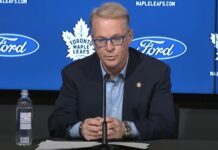Let’s get one thing straight: this year is a write-off. The rest of the games scheduled for the Maple Leafs are not happening, at least not in any meaningful sense. Instead, the events you will be watching on your large-screen TVs over the course of twenty-six evenings littered throughout the next two and a half months are best considered nought but a demonstration or experiment of sorts.
Brian Burke has opened up a chemistry lab; you better believe he’ll be looking at team chemistry very carefully for the rest of this year.
Last summer, I wrote an article for the Maple Leafs Annual that looked at where the Leafs were on the path to rebuilding. I argued that Burke would not be following the same path that teams like Washington, Pittsburgh and Chicago had before him. I argued that he couldn’t, for reasons related to the salary cap and the number of No Movement/No Trade clauses that the Leafs had to deal with. I suggested that Burke’s first halting steps toward building a competitive club down the road were an effort to simply add assets to the team in a non-destructive manner. Last summer, youth and economical talent were added to the mix via free agency where they could be acquired without compromising cap or roster flexibility; I suggested that what we were seeing was but the first step in an iterative process by which Leafs management would identify a sort of cohort of youthful talent around which their plans for the future would revolve. I suggested that the process was unlikely to be overly reliant on the draft and that what we were likely to see was a repetitive churning of the roster over a period of two to three years.
Today, Burke and the Leafs completed two trades that represent a significant overhaul of the roster. Six regulars (Stajan, Hagman, White, Mayers, Toskala and Blake) move on to other destinations. It is expected that the players coming to the Leafs will occupy three roster spots in the immediate future – Giguere, Phaneuf and Sjostrom – with prospect defenseman Keith Aulie set to report to the Marlies. These trades represent a churning of the roster in an effort to find that quixotic blend of players with just the right mix of offense, defense, goaltending, leadership and team cohesion. The occasion seems proper for at least a preliminary assessment of where we are now along the path to success.
For the reasons set out below, I think it’s safe to assume that a positive step has been taken towards contending, a positive step that is consistent with the big picture plan. It has to be stressed, though, that this is but a station stop on the way to respectability. These are moves that had to be made, but they do not represent an end or destination point.
________________
Goal — The Plan: In my article in the Annual, I suggested that this season represented a wait-and-see type of test for the Leafs— goaltenders. Going in to the season, the Leafs were dealing with two unknown quantities: whether Gustavsson could make the transition from a Swedish Elitserien standout to an NHL regular, and whether a surgically repaired Vesa Toskala could regain any credibility as an NHL-calibre puckstopper. I think it was obvious that Toskala—s role was a limited one; after last season—s horror show, I doubt whether many truly foresaw the enigmatic Finn assuming a leading role on any competitive Leaf team in the years to come. Instead, it seemed clear that the plan was for a surgically repaired Toskala to hopefully bounce back enough to carry the majority of the workload in goal, at least for long enough to give Burke and Wilson the opportunity to pick their spots, working The Monster into games in carefully controlled situations. Gustavsson had to get enough work to permit them to evaluate whether they had found a long-term solution in net, but not too much to derail his development or jeopardize the competitive viability of the team. The idea was to get through the season (and a year of Vesa—s contract) and then determine whether it was necessary to continue looking elsewhere for our starting goalkeeper.
Goal – Update on The Plan: Well, we all know how that worked out. For starters, every Tom, Dick and Gianni from Woodbridge is now intimately familiar with what an “ablation” procedure is: Gustavsson’s year-long developmental audition was derailed almost from the very beginning by medical concerns and two lengthy stays in hospital. Alarmingly, however, “Gustavsson’s two heart surgeries” is not the answer to the question “What’s the worst thing that has happened in the Leafs’ net this year?” That fact alone ought to tell you how Toskala responded to the task set out for him. Whether he was injured, disinterested or just flat-out completely washed up, Toskala so vigorously and spectacularly shat the bed when called upon to play that he had officially entered the Andrew Raycroft zone: a sullen, baseball-cap wearing opener of doors. There were exceptions to the general rule: two wins against the Capitals, a December 9th game against the Islanders and a shutout performance against the Flyers are some occasions that come to mind. All too often, however, Toskala’s incompetence or inability was readily apparent to even the most casual observer. Burke says it was coincidence that the trade happened today, after Toskala and the Leafs surrendered a 3-0 lead to the Canucks in a sixty-minute monument to futility last night, but it is no coincidence that action at the goal position was taken before this year came to an end. Toskala’s struggles had forced Wilson and Burke into the position of designating the rookie Swede as their number one goaltender. That was bad news for a number of reasons, among them being the fact that Gustavsson has, for his own part, failed to impress. Having given up on Justin Pogge, however, and with little youthful help in net evidently available from their minor-league affiliate, the Leafs were about to get themselves in a bit of a bind when Jonas Gustavsson’s agent started to make unreasonable demands. The point is that it is still too soon to say one way or the other whether Gustavsson can do the job long-term; he’s shown flashes of brilliance at times, it’s true. He’s also struggled noticeably with at least two key aspects of his game: puck handling and (more troublingly) the tendency to aggressively over-commit to a shooter by moving laterally with such decisiveness that he is unable to recover to defend against cleverly disguised passes or fortuitous bounces. With those questions and issues surrounding his health still to be answered, Gustavsson nevertheless stood to come to the bargaining table in a relatively strong position as the only credible existing suitor for the job as Leafs’ starter.
By acquiring J.S. Giguere, Brian Burke has likely stabilized the Leafs in goal until next year’s trade deadline. Giguere, as a player who achieved his greatest successes under the instruction of Leafs’ goaltending coach Francois Allaire, will be called upon to carry the mail as and when required, and to mentor Gustavsson. Giguere carries an enormous contract and a sizeable ($6 Million) cap hit; his addition to the club reduces roster flexibility at the position somewhat, but (as we have seen), when it comes to challengers for the number one job, there is little reason to look beyond Gustavsson within the organization. A look at the list of pending RFA goaltenders this summer ought to be enough to convince you that no such challenge is coming from without either. The important point to remember in understanding today’s moves is that is unlikely that Giguere himself is seen as the final piece of the puzzle by Burke or Wilson. Giguere has himself struggled with poor play this season. The bottom line, however, is that he can’t be worse than Toskala and the Leafs won’t be competing for a Cup next year anyway, so it doesn’t matter if Jiggy is eating up cap and roster space in 2010-11. Rather, the expectations for him are much more modest: provide a limited upgrade over Toskala and pass along the wisdom of a Cup champion goaltender to the prospect. I would be absolutely shocked now if Gustavsson were not signed by the Leafs at the end of this year, likely to a deal that is modest in term (two years?) and quantum. The evaluation of Gustavsson can and will continue, and with Giguere available to put in minutes as required for the next year or so in either a leading or supporting capacity, the plan to watch, evaluate and continue to await the answer in goal will carry on. The unplanned development here is adding the additional year of big salary/cap hit for a goalie that probably won’t be around when the team truly competes.
Goal – Evaluation: Many in Toronto would consider it a success for Burke to get another GM’s signature on any trade of a living body for Vesa Toskala; any time that can be achieved without resort to extortion, hypnosis or outright fraud, you’d have to declare the transaction a success. The attractiveness of this trade is only enhanced by the cap and roster space relief it will provide the Leafs in 2012 by relieving the club of the aging and underachieving Jason Blake.
_________________
Forward – The Plan: In August of last year, I wrote that:
[t]he odds are not good that Jason Blake, Matt Stajan, Lee Stempniak, and Jamal Mayers will all finish the season with the Leafs. It would not be surprising in the least if none of these four returned to the Leafs roster next year as Stajan, Stempniak and Mayers are all scheduled to become free agents and Jason Blake (who will be 36 in September) will be an expendable – and possibly marketable – piece of the puzzle at this year’s trade deadline¦The bottom line is¦that a great deal of churning may be expected to occur over the next two years or so, as players come into the organization via trade or free agency to replace failed prospects or aging players who are moved out.
Significant roster space at the forward position has rather obviously been created. Space has been cleared for the young prospects in the organization to challenge for everyday roles. Expect many of them to struggle in that regard. Keep in mind that this is part of the plan, or (perhaps more accurately) that it is planned for. The most obvious and immediate benefactors of these opportunities will be Jay Rosehill, Tyler Bozak, Viktor Stalberg and Christian Hanson. Nazem Kadri may find his path to the bigs a little clearer come next season as well, though I personally believe that he ought to spend a full season in the AHL. There will be other forwards to come, to replace those among the present crop who prove unequal to the challenge, or who fail to provide the requisite chemistry (particularly as it relates to Phil Kessel’s linemates).
Forward – Update on the Plan: Burke is far from done at the forward position, you can bank on that. Of the forwards leaving the team, the only one who I felt had a chance to play a role on the Leaf team of the future was Nik Hagman, who represented scoring talent at an economical price. Significant turnover at the forward position was expected. Leaf fans should be glad that Burke seems to have managed to turn a number of rapidly expiring assets (Stajan, White and Mayers are all scheduled to become free agents at the end of the year) into other assets. Leaf fans should be overjoyed that Jason Blake’s contract, the salary cap equivalent of a pulmonary embolism, has been removed from the mix.
Forward – Evaluation: In the near term, the Maple Leafs will suffer at forward. The team has become significantly more inexperienced up front and almost laughably thin down the middle especially. The injured Mikhail Grabovski is probably the best of the remaining centres with any significant previous NHL experience prior to this season; beyond the diminutive pineapple-hating pivot, a badly regressing John Mitchell and a horribly incompetent Rickard Wallin are noticeably inferior to promising rookie Tyler Bozak. You don’t have to be the Amazing Carnac to see Burke’s attention turning to the centre ice position as the trade deadline approaches and the summer free agent season begins. Obviously, the group that’s listed on the roster right now will not all be around in two years’ time. Today’s moves fit the plan by clearing space for the moves of tomorrow; tomorrow’s moves will determine how much progress is made towards the ultimate goal.
________________
Defence – The Plan: I believed that Burke had likely addressed most of his concerns on defence last summer with the signing of Francois Beauchemin and Mike Komisarek. It was pretty clear then that the plan was for a top four consisting of Komisarek, Beauchemin, Schenn and (provided he remained with the club) Kaberle. It would be left to the depth defencemen, guys like Ian White, Jeff Finger, Garnet Exelby, Mike van Ryn and Jonas Frogren to fight it out for minutes at the fifth and sixth position. Moves might be made at the margin, but the basic building blocks seemed carefully arranged, with the only major move likely relating to a trade of Tomas Kaberle. White, of course, ended up developing into one of the Leafs’ more consistent defenders this season, playing top four minutes at times while (at various times) Komisarek has battled injuries, Schenn has battled inconsistency and Exelby and Finger learned the path to and from the pressboxes of the league. Meanwhile, van Ryn (injury) and Frogren (assignment to the Marlies) have been non-factors, and Carl Gunnarson has emerged somewhat unexpectedly as a pleasant and apparently capable surprise.
Defence – Update on the Plan: Acquiring Dion Phaneuf really puts the cat among the pigeons on the blueline. The most obvious signal that may arise from this move is that Tomas Kaberle’s time as a Maple Leaf is coming to an end. It is difficult to believe that Burke would give up on either of his own free agent acquisitions, so Komisarek and Beauchemin must be presumed to be safe for the moment. Schenn’s combined youth and talent are an unbeatable combination in a salary cap league, likely meaning that he and the newcomer Phaneuf are at least targeted to play top four minutes. That likely leaves Kaberle on the outside of the top four looking in, if not at the trade deadline this year, certainly before next year’s deadline. For the moment, the plan may be to rely on Kaberle and Phaneuf to present a threat on the powerplay’s backline, demanding some attention from opposition penalty killers and hopefully opening up some space for Phil Kessel to get something done with the extra man. In that short term time horizon, Schenn may play third-pairing minutes while Burke searches for the right opportunity to move Kaberle and clear a spot. In the long term, however, unless Burke determines that either Beauchemin or Komisarek is expendable, Kaberle’s days in the Blue and White seem numbered.
Defence – Evaluation: I am a little surprised that so major a move involving the defence was made so soon after last summer’s upgrades. That having been said, it occurs to me that this is the sort of deal that is full of potential for the Leafs. If Phaneuf can regain even some of the promise he showed early in his career, at age 24 he is potentially a long-term cornerstone on defence. Likely all that remains at this point is the shuffling of the extra pieces; something will have to be done about Jeff Finger and his enormous contract. Garnet Exelby will be shuffled out and Mike van Ryn won’t be re-signed; any return for Exelby will be a bonus. The move is consistent with the plan; youth and talent have been acquired (admittedly at the expense of some salary cap flexibility). My gut feeling is that Burke was somewhat surprised that this deal was there to be made; he got an (admittedly struggling) but potentially franchise-calibre defenceman with offensive skills in exchange for a second-line scorer (Hagman), and the rental of Matt Stajan, Ian White and Jamal Mayers. This trade has the potential to cost Darryl Sutter his job if Phaneuf reverses his course.
________________
Overall Assessment: These moves are generally consistent with the long-term plan. Some roster and salary cap flexibility for next season have been sacrificed, but it seems clear that the Leafs do not expect to seriously contend for a championship next year. That may be the single most important thing to remember when evaluating these moves; it’s not about this year or even next. It’s about setting the table for what comes after that.


































